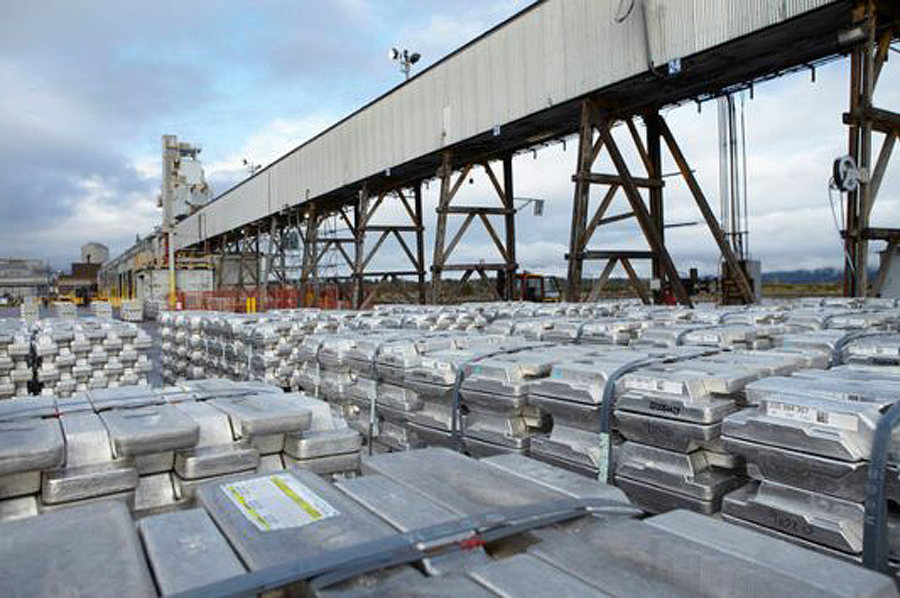
(The opinions expressed here are those of the author, Andy Home, a columnist for Reuters.)
China imported another 220,000 tonnes of unwrought aluminum in October, extending one of the most unexpected trends in a year of metals market upheaval.
Net imports of primary aluminum and alloy totalled 1.74 million tonnes in the first 10 months of the year. That already exceeds the 1.43 million tonnes imported in the whole of 2009, the last time the world’s largest producer turned to the international market for supply.
Outright imports of primary metal, at 880,000 tonnes so far this year, are running lower than during the Global Financial Crisis, when they reached almost 1.5 million tonnes. But imports of alloy have exceeded one million tonnes, compared with just 243,000 tonnes in 2009.
This unprecedented flow of unwrought alloy gives some clues as to the forces currently reshaping China’s aluminum trade with the rest of the world.
The strength of China’s manufacturing rebound from the depths of the COVID-19 lockdown in the first quarter has galvanised all the industrial metals, with imports of copper also running at record levels this year.
But aluminum demand has been exceptionally strong.
Goldman Sachs estimates that Chinese demand fell by 1% year-on-year in the first quarter but has since registered accelerating growth of 17%.
Goldman estimates that China’s scrap supply has fallen by around 1.5 million tonnes this year
Similar to other metals, aluminum has benefited from a strong catch-up recovery in the automotive sector as well as state-led investment in ultra-high-voltage power-lines and solar capacity.
Aluminum is also experiencing rising intensity of usage in construction, which along with infrastructure is one of the main channels for government stimulus.
The metal is already widely used for roofing and window frames. But, according to Goldman Sachs, the biggest change is the switch from wood to aluminum for casting form work in the channels used to lay concrete.
The use of aluminum alloy for construction casting of high-rise buildings began in the 2000s but has really taken off in the last few years thanks to the metal’s light weight and recyclability.
New government guidelines on reducing construction waste in May 2020 have translated into eight provinces issuing preference policies on aluminum alloy casting form work usage.
Goldman estimates that this relatively new application will boost the amount of metal used in construction by 500,000 tonnes this year relative to 2019.
While Chinese demand for aluminum alloy is booming, domestic supply has struggled to keep pace.
Many forms of alloy are made by blending in secondary (scrap) metal and this is the part of the global aluminum supply chain that has been most impacted by covid-19.
Early-year hits to manufacturing activity have meant less new scrap, while the collection of old scrap has been massively disrupted by lockdowns around the world.
China, which has historically been the world’s largest buyer of aluminum scrap, has compounded this global shortfall by its clampdown on what it has dismissed in the past as “foreign garbage.”
Early-year hits to manufacturing activity have meant less new scrap, while the collection of old scrap has been massively disrupted by lockdowns around the world
A new import code, identifying some higher-purity forms of scrap as a “resource”, is in the process of being implemented but so far there has been no discernible effect on the dwindling amount of aluminum scrap being imported.
Cumulative scrap imports of 680,000 tonnes so far this year are down 48% year-on-year, and October’s tally of 47,300 tonnes was the lowest monthly total yet.
Goldman estimates that China’s scrap supply has fallen by around 1.5 million tonnes this year “which has meant a diversion on that scale from secondary to primary produced aluminum, as well as alloy imports”.
Displaced scrap demand has impacted the unwrought primary ingot segment of the supply chain. That too is facing structural problems.
Ever more Chinese producers are delivering molten metal straight to fabricators clustered in “aluminum hubs” around the smelters.
This means less metal ingot, precisely the form of metal that is traded on the Shanghai Futures Exchange and the London Metal Exchange (LME).
Chinese production of aluminum has expanded by more than two million tonnes annualised so far this year, but increased integration with fabricators has left a gap in the primary-metal sector, which is being compounded by a synchronised hit to the scrap-alloy component of the market.
Global scrap supply chains should recover next year and China’s new import rules should see a lift in imports, although by how much is a moot point as trade flows have shifted, possibly permanently, over the last couple of years.
Moreover, the squeeze on scrap in China itself may persist as the shanty-town renovation programmes, a big source of old recyclable metal, are wound down after this year, Goldman argues.
The bank notes that domestic scrap accounts for around four million of the 5.6 million tonnes of alloy produced in China each year.
The bank is bullish on China’s imports of both primary and alloy aluminum going forward, suggesting that the current import flood is more structural than the flash surge of 2009.
The market seems collectively to agree; witness the shift in global stocks of primary aluminum away from the United States and Europe to LME locations in Malaysia, South Korea and Singapore.
These three countries between them hold 1.16 million tonnes of LME-registered aluminum, representing 86% of total exchange stocks. They are all within easy shipping distance of China.
The pace of Chinese imports has abated over the last couple of months relative to July and August but they remain high by any other historical yardstick including the trade inversion of 2009.
Given the structural issues around domestic scrap and ingot availability, there may be more to come next year.
(Editing by Pravin Char)
Comments